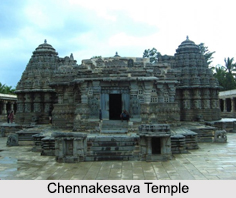 Chennakesava Temple, also known as Somnathpur Temple is a popular shrine located in Somanathapura town, about 35 km away from Mysuru. This temple still stands majestically as one of the finest exemplary of Hoysala Architecture. It has been also nominated for the status of UNESCO World Heritage Site and is maintained by the Archaeological Survey of India (ASI).
Chennakesava Temple, also known as Somnathpur Temple is a popular shrine located in Somanathapura town, about 35 km away from Mysuru. This temple still stands majestically as one of the finest exemplary of Hoysala Architecture. It has been also nominated for the status of UNESCO World Heritage Site and is maintained by the Archaeological Survey of India (ASI).
History of Chennakesava Temple
Chennakesava Temple was built by Somanatha, a Dandanayaka in 1268 C.E. under Hoysala king Narasimha III, when the Hoysala Empire was the major power in South Indian political scenario. By this time, Hoysala reign was already more than 250 years old. It is said that Dandanayaka Somanatha, after establishing a village on the banks of Cauvery River named Somanathapura, had taken the permission of King Narasimha III to create a temple dedicated to Lord Vishnu. The temple was created not only to seek blessings of the lord but also to showcase the enviable brilliance of Hoysala architecture and to represent its grandeur and intricate craftsmanship.
Architecture of Chennakesava Temple
Chennakesava Temple is a Trikuta, meaning three shrine temple. Each shrine has its own Vimana and Sukanasi. The porch has lathe turned pillars, decoratively sculpted. The three shrines with the Vimanas and Sukanasis are in perfect symmetry. The shrines are built on a raised platform. The three shrines are built in a 16 point star-shaped plan.
The temple has two attics, with decorative miniature towers running between the two eaves. Below the lower attic is a running frieze of around 200 panels that depict various Hindu Gods and Goddesses. At the lower level, there is a frieze of panels depicting scenes from the great Indian Epics. The south side walls feature panels showing scenes from the Ramayana, the rear wall has panels from the life of Lord Krishna and the north side wall depicts scenes from the Mahabharata.
Deity and Sculptures of Chennakesava Temple
Of the three shrines of Chennakesava Temple, one shrine has the image of the God Keshava, but the image is missing from the sanctum. The other two shrines house images of Janardhana and Venugopala (all three images are forms of the Hindu God Vishnu). This is strictly a Vaishnava temple and there are no depictions of any forms of the Hindu God, Lord Shiva or Mahadeva.
Other sculptures of Chennakesava Temple include depictions of affluence of that age including members of the royal family riding richly decorated chariots, soldiers and commoners riding horses, camel drawn vehicles, dancers, musicians, hunters armed with bows and arrows and accompanied by their dogs, all heading for a hunt.
There are sculptures in Chennakesava Temple of royal palaces protected by armed guards, intricate carvings of jewellery, such as pendants, necklaces, waistbands and rings and of woman sporting hair styles that were in vogue.
Visiting Information of Chennakesava Temple
Chennakesava Temple is located in Somanathapura town. It is located about 35 km from Mysuru and 137 km from Bengaluru. There are many buses from Bengaluru, Mysuru and Srirangapatnam to Somanathapura.



















